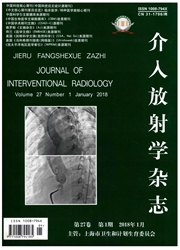

 中文摘要:
中文摘要:
目的回顾性分析和比较应用暂时性贲门支架置入,与相同直径的球囊扩张两种方法治疗贲门失弛缓症患者的长期随访结果。方法 101例贲门失弛缓症患者按不同治疗方式,分为球囊扩张治疗组(A组;n=38)和暂时性贲门支架治疗组(B组;n=63)。球囊和支架直径均为30 mm。临床症状评分(TSS)和食管测压用于评价患者临床症状和食管下段括约肌(LES)压力改善,食管钡餐检查作为评价食管排空的客观指标。随访期间记录TSS和LES压力变化并进行比较。结果 A组38例共行49次球囊扩张,B组63例共行65次支架置入,均在透视引导下成功施行。术后并发症包括疼痛、反流和出血,在A组中上述症状分别为9例(23.6%)、8例(21.1%)和3例(8%);B组中分别为27例(42.9%)、8例(12.7%)和10例(15.9%)。支架置入时间为4~7 d,后经胃镜取出。术后两组患者TSS、食管测压和钡餐检查均较术前明显改善。A组平均随访(71.3±40.9)个月,B组平均随访(53.9±36.2)个月,随访结束时A组TSS和LES压力分别为(10.20±0.45)和(58.60±8.65)mmHg,而B组分别为(4.00±1.0)(P=0.009 6)和(43.67±12.66)mmHg(P=0.168 7)。Kaplan-Meier曲线表明在〉10年随访中,B组的症状缓解优于A组(P=0.0212)。结论长期随访研究表明,与相同直径的球囊扩张相比,暂时性贲门支架置入治疗贲门失弛缓症患者具有更好的疗效。
 英文摘要:
英文摘要:
Objective To retrospectively analyze and compare the clinical efficacy of temporary stent insertion with pneumatic dilation at the same diameter for the treatment of achalasia based on a long-term follow-up observation.Methods A total of 101 treated achalasia patients were divided into pneumatic dilation group(group A,n = 38) and temporary stent insertion group(group B,n = 63).The diameter of the balloon and stent used for the procedure was 30 mm.The total symptom scores(TSSs) and esophageal manometry was used to assess the symptoms and lower esophageal sphincter(LES) pressure improvement.Barium-swallow-esophageal study was employed to objectively evaluate the esophageal emptying function.TSSs and LES pressure improvement were assessed,recorded and compared during the regular interval follow-up.Results Forty-nine pneumatic dilations and 65 stent insertions were successfully performed in all patients under fluoroscopic guidance.Complications included pain,reflux and bleeding,which occurred in 9(23.6%),8(21.1%) and 3(8.0%) patients in group A,respectively,while in 27(42.9%),8(12.7%) and 10(15.9%) patients in group B,respectively.The stent was retained approximately 4-7 days and all stents were retrieved via endoscope.TSSs,esophageal manometry and postoperative barium esophagram showed significant improvement compared to those obtained before treatment(P 0.000 1).At the end of follow-up,TSSs and LES pressure in group B were 4.00 ± 1.00 and(43.67 ± 12.66) mmHg,respectively,which were 10.20 ± 0.45(P = 0.0096) and(58.60 ± 8.65) mmHg(P = 0.1687),respectively,in group A.The Kaplan-Meier curve revealed that group B obtained a better symptom remission than group A did(Log-rank test;P = 0.021 2).Conclusion Long-term follow-up results indicate that for the treatment of achalasia retrievable stent placement is more effective than same diameter pneumatic dilation therapy.
 同期刊论文项目
同期刊论文项目
 同项目期刊论文
同项目期刊论文
 Comparison of tissue reaction with three different endografts used for exclusion of carotid artery a
Comparison of tissue reaction with three different endografts used for exclusion of carotid artery a Management of acute malignant colorectal obstruction with a novel self-expanding metallic stent as a
Management of acute malignant colorectal obstruction with a novel self-expanding metallic stent as a Comparison of temporary stent insertion with pneumatic dilation of the same diameter in the treatmen
Comparison of temporary stent insertion with pneumatic dilation of the same diameter in the treatmen Application of the newly developed stents in the treatment of benign cardia stricture: an experiment
Application of the newly developed stents in the treatment of benign cardia stricture: an experiment 期刊信息
期刊信息
